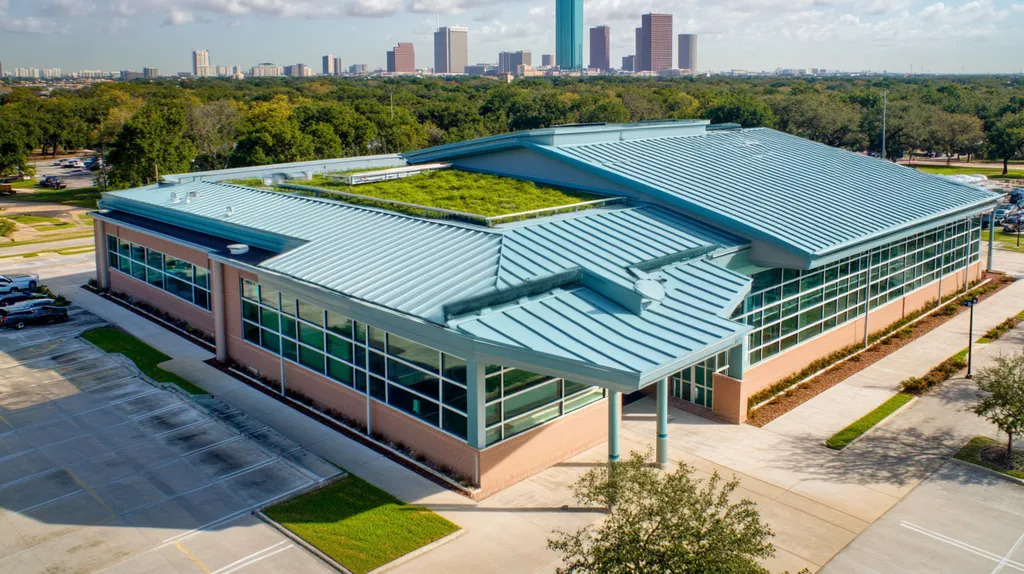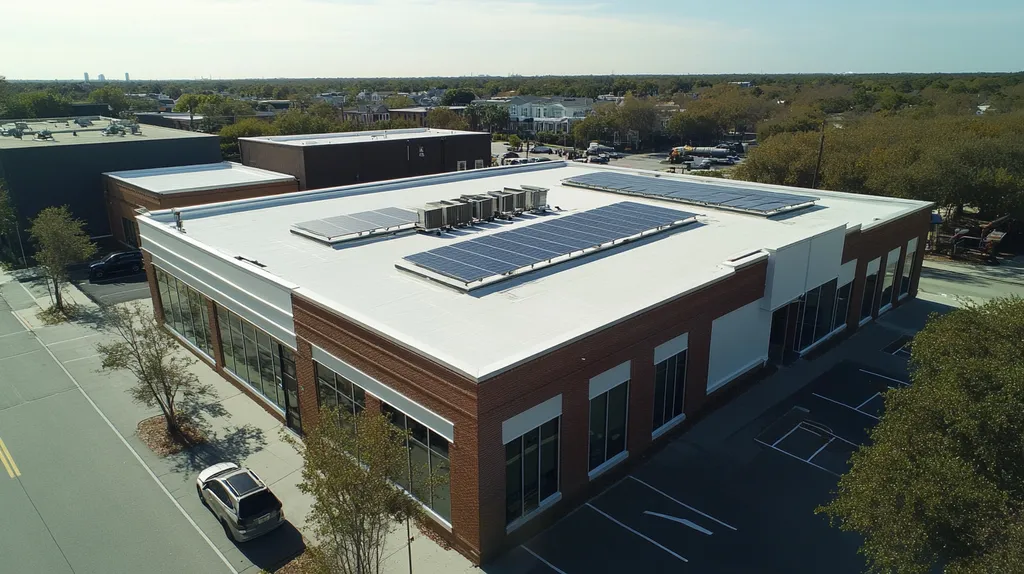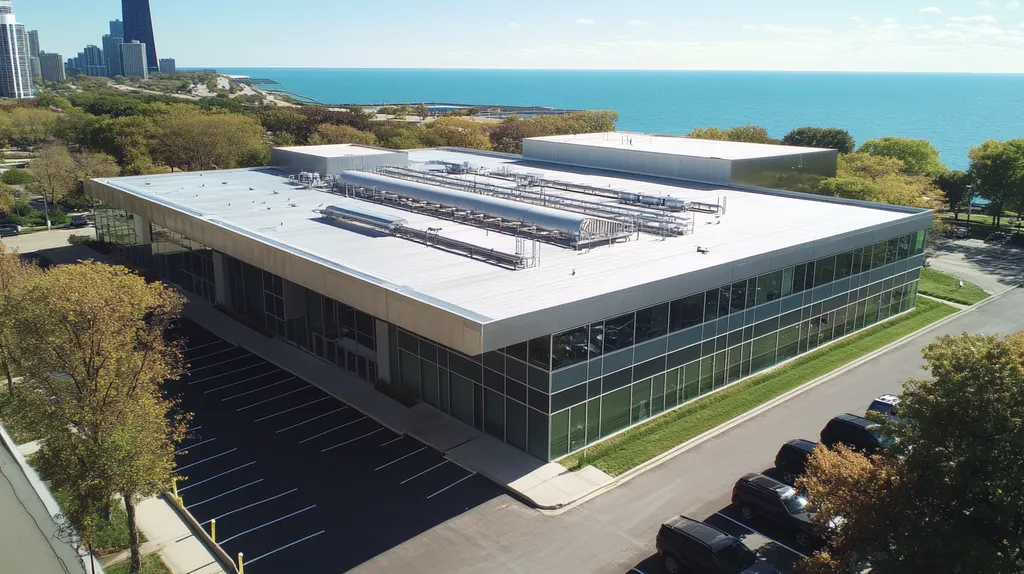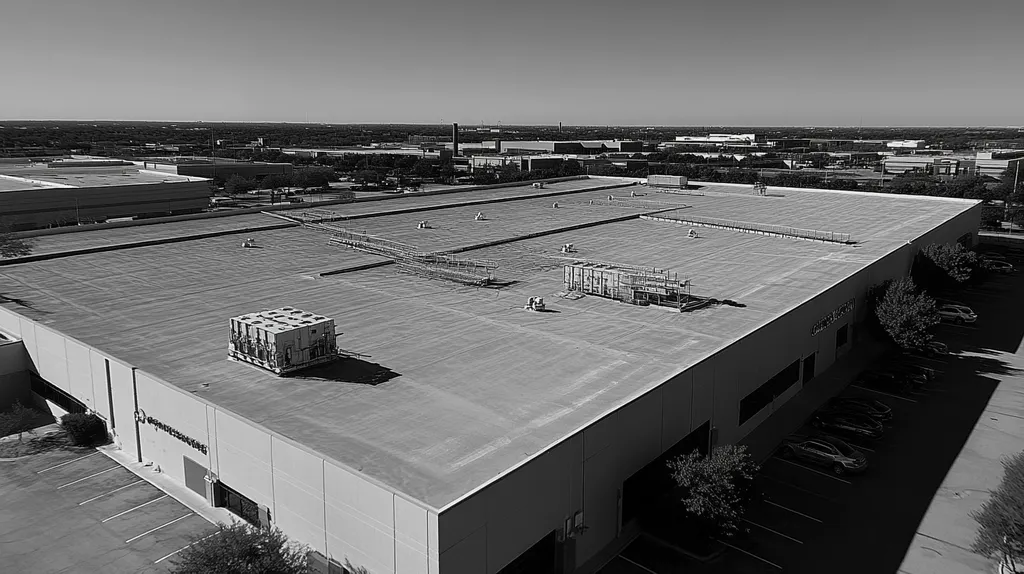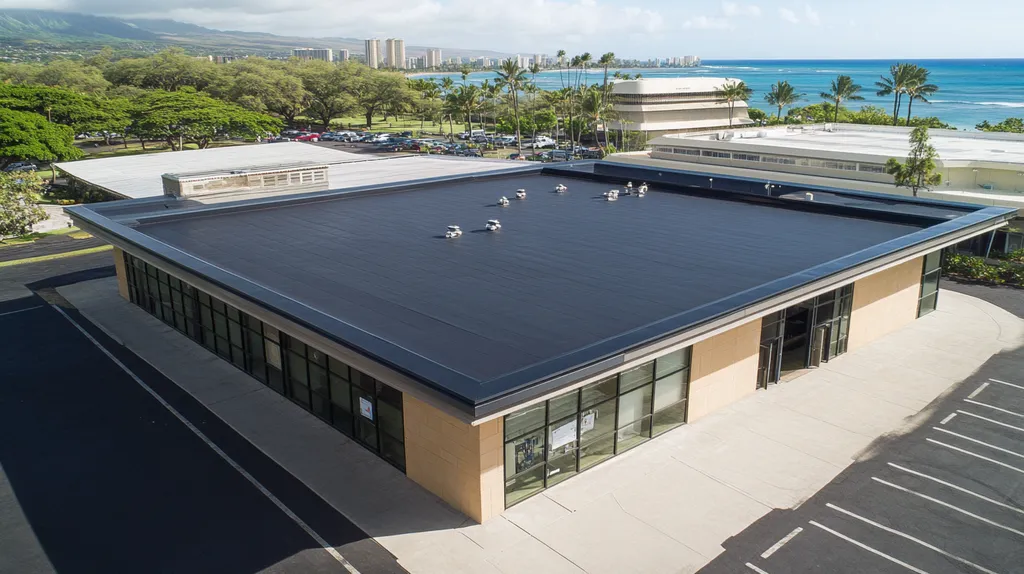Welcome to today’s Battle Royale featuring two roofing heavyweights: “Historic Restorative Roofing Systems” in the east corner versus “Traditional Slate Roofing” in the west!
Tonight’s showdown pits these contenders against each other across six punishing rounds designed to test every aspect of their performance for maintaining historical accuracy in commercial roofs.
At stake? Millions in potential costs, decades of building protection, and the critical performance demands of modern commercial and industrial facilities.
Our professional judging panel will evaluate each round on technical merit, real-world performance, and value delivery. After all six rounds, we’ll declare our ultimate champion.
Ladies and gentlemen, facility managers and building owners… it’s time to rumble!
ROUND 1: INITIAL COSTS & INSTALLATION
When preserving historical commercial buildings, roofing decisions carry significant financial and architectural implications. Every material choice and installation method must balance historical authenticity with modern building requirements. Property owners face increasing pressure to maintain historical accuracy while managing budgets and project timelines effectively.
Material Expenses
Material selection dramatically influences both initial investment and long-term building preservation. Traditional slate roofing requires specially quarried natural stone, with costs typically ranging from $15 to $30 per square foot for materials alone. Premium slate varieties needed for exact historical matches can push costs even higher.
Historic restorative roofing systems utilize advanced materials engineered to replicate historical appearances. These materials generally cost 40-60% less than natural slate while delivering comparable aesthetic results.
Quality variations in synthetic materials can affect long-term performance, requiring careful supplier selection. However, the significant cost savings and broader material availability give historic restorative systems a clear ADVANTAGE in material expenses.
Installation Complexity
Traditional slate installation demands specialized skills that few modern roofers possess. Each slate piece requires precise cutting, positioning, and securing using historical methods. This specialized requirement often limits contractor options and increases labor costs.
Historic restorative systems can be documented and installed using modern technology and techniques. Photogrammetry allows for precise measurement and replication of historical details, ensuring accuracy while simplifying installation. (source: National Park Service)
While both systems require attention to detail, restorative systems’ compatibility with contemporary installation methods gives them an ADVANTAGE in implementation.
Project Timeline
Timeline considerations directly impact business operations and project costs. Traditional slate installation typically requires 2-3 times longer than modern roofing methods due to the precision required for each piece.
Historic restorative systems can generally be installed within standard commercial roofing timeframes. Their simplified installation process reduces both project duration and the risk of weather-related delays.
The efficiency and predictability of restorative system installations create less disruption to building operations. This gives historic restorative systems the ADVANTAGE in project timeline management.
ROUND 1 WINNER: Historic Restorative Roofing Systems
ROUND 2: DURABILITY & LIFESPAN
In commercial roofing, durability and lifespan considerations can make or break a historical restoration project. With average replacement costs exceeding $250,000 for commercial buildings over 10,000 square feet, selecting materials that balance longevity with historical authenticity becomes crucial. Weather exposure, maintenance requirements, and environmental factors all play vital roles in determining a roof’s long-term viability.
Material Resilience
The resilience of roofing materials directly impacts both preservation efforts and building protection. Traditional slate roofing has demonstrated exceptional durability, with many installations lasting well beyond 100 years when properly maintained. Its natural density and composition provide superior resistance to UV radiation, freeze-thaw cycles, and extreme weather events.
Historic restorative systems utilize engineered materials that replicate traditional appearances while incorporating modern protective features. These systems typically offer 30-50 year warranties but haven’t yet proven their century-plus longevity potential in real-world applications.
Finding craftsmen with the expertise to properly install and maintain historical roofing systems presents a significant challenge in both approaches. (source: Dynasty Building Solutions)
Given its proven track record of multi-generational performance, traditional slate earns the ADVANTAGE in material resilience.
Maintenance Requirements
Regular maintenance significantly influences roof longevity and historical authenticity. Traditional slate requires specialized knowledge for repairs, with each damaged piece needing careful matching and skilled replacement. These maintenance operations must occur regularly to prevent water infiltration and structural deterioration.
Historic restorative systems typically incorporate modern maintenance protocols that facility teams can more easily execute. Their engineered materials often feature enhanced impact resistance and simplified repair procedures that reduce maintenance complexity.
While both systems demand ongoing attention, restorative systems’ easier maintenance protocols earn them the ADVANTAGE in this category.
Weather Resistance
A roof’s ability to withstand regional weather patterns directly affects its service life. Traditional slate exhibits excellent natural resistance to wind, hail, and thermal cycling, but individual pieces can crack or dislodge under severe impact.
Historic restorative systems incorporate modern engineering that often exceeds traditional materials in extreme weather performance. Their synthetic components typically offer superior wind resistance and impact protection while maintaining historical appearances.
The enhanced weather resistance capabilities of modern materials give historic restorative systems the ADVANTAGE in this category.
ROUND 2 WINNER: HISTORIC RESTORATIVE ROOFING SYSTEMS
ROUND 3: PERFORMANCE FACTORS
Performance factors in historical commercial roofing directly impact building integrity and operational costs. Without proper performance considerations, even historically accurate roofs can fail prematurely, leading to structural damage and expensive repairs. Modern facility managers must evaluate how different roofing systems handle thermal stress, moisture management, and environmental challenges while maintaining historical authenticity.
Thermal Management
Temperature fluctuations create significant stress on commercial roofing systems. Daily heating and cooling cycles cause materials to expand and contract, potentially compromising historical accuracy through warping or separation.
Historic restorative systems incorporate modern materials engineered to handle thermal cycling while maintaining period-appropriate appearances. These systems typically include thermal breaks and expansion joints that prevent stress-related damage.
Traditional slate roofing relies on natural thermal properties and installation techniques developed over centuries. While effective, slate’s rigid nature can make it more susceptible to thermal stress, particularly in regions with extreme temperature variations.
The advanced thermal management capabilities of modern materials give historic restorative systems the ADVANTAGE in this category.
Moisture Control
Water infiltration represents the primary threat to historical commercial buildings. Proper moisture management prevents rot, mold, and structural deterioration that can compromise both building integrity and historical value.
Historic restorative systems feature contemporary moisture barriers and drainage planes that work invisibly behind historically accurate surfaces. These systems often incorporate modern ventilation techniques that prevent moisture accumulation.
Traditional slate provides excellent natural water shedding but relies heavily on proper underlayment and flashing details. While highly effective when properly installed, slate systems offer limited options for incorporating modern moisture management technologies.
The integration of advanced moisture control features gives historic restorative systems the ADVANTAGE in this category.
Environmental Resistance
Commercial roofs must withstand increasingly severe environmental challenges while preserving historical character. UV exposure, pollutants, and biological growth can degrade roofing materials and compromise historical accuracy.
Historic restorative systems incorporate UV-resistant materials and anti-microbial treatments that extend service life. These protective features help maintain historical appearances despite harsh environmental conditions.
Traditional slate offers natural resistance to environmental factors through its mineral composition. Its proven track record spans centuries of exposure to industrial pollution and harsh weather conditions.
The natural durability and proven environmental resistance of slate gives traditional slate roofing the ADVANTAGE in this category.
ROUND 3 WINNER: Historic Restorative Roofing Systems
ROUND 4: MAINTENANCE REQUIREMENTS
Maintenance requirements represent a critical factor in preserving historical commercial roofs, with improper upkeep potentially leading to catastrophic failures. Regular inspection and maintenance costs can range from 2-4% of initial installation costs annually, making this a significant consideration in total ownership expenses. Understanding these requirements helps property owners make informed decisions about roofing system selection and budget allocation.
Regular Inspection Requirements
Historic restorative roofing systems demand quarterly professional inspections to monitor material integrity and historical accuracy. These inspections must evaluate both aesthetic consistency and structural performance, requiring specialized knowledge of both modern and historical roofing techniques.
Early detection of potential issues helps prevent escalating damage and maintains historical authenticity. However, finding qualified inspectors who understand both modern materials and historical preservation standards can prove challenging.
Traditional slate roofing typically requires only bi-annual professional inspections when properly installed. The simplicity and durability of natural slate make issues easier to identify and assess during routine maintenance checks.
The reduced inspection frequency and straightforward assessment criteria give traditional slate roofing the ADVANTAGE in this category.
Repair Complexity
Historic restorative systems often require specialized repair techniques that combine modern methods with historical aesthetics. Matching replacement materials and maintaining period-appropriate appearances during repairs demands extensive knowledge of both contemporary and historical practices.
The complexity of these repairs often necessitates manufacturer-certified contractors, limiting repair options and potentially increasing response times. Even minor repairs must carefully balance modern durability with historical accuracy.
Traditional slate repairs follow well-established methods that have remained largely unchanged for centuries. While finding qualified slate roofers can be challenging, the repair techniques themselves are straightforward and proven effective.
The simplicity and reliability of traditional repair methods give traditional slate roofing the ADVANTAGE in this category.
Long-term Maintenance Costs
Historic restorative systems typically require more frequent maintenance interventions to maintain their historical appearance. Material replacement costs can vary significantly based on manufacturer availability and changing product lines.
These systems often need specialized cleaning and treatment protocols to preserve their engineered properties while maintaining historical aesthetics. The complexity of these maintenance requirements can increase long-term ownership costs.
Traditional slate roofing benefits from minimal maintenance requirements beyond basic cleaning and occasional repairs. When properly maintained, slate roofs can last over a century with relatively modest annual maintenance expenses.
The lower long-term maintenance burden gives traditional slate roofing the ADVANTAGE in this category.
ROUND 4 WINNER: TRADITIONAL SLATE ROOFING
ROUND 5: SUSTAINABILITY CREDENTIALS
Environmental impact and sustainability now drive many commercial roofing decisions, with regulations and market demands pushing property owners toward greener solutions. The roofing industry generates over 11 million tons of waste annually, making material choices and installation methods critical factors in reducing environmental impact. Historical buildings present unique challenges in balancing preservation requirements with modern sustainability standards.
Lifecycle Assessment
The environmental impact of roofing materials extends from manufacturing through disposal. Traditional slate roofing requires significant energy for quarrying and transportation, though its century-plus lifespan helps offset initial carbon costs.
Historic restorative systems often incorporate recycled materials and modern manufacturing processes designed to minimize waste. These systems typically achieve 30-50 year lifespans while requiring fewer raw materials during production.
Material compatibility with original construction methods plays a crucial role in sustainability assessment. (source: EcoSteel)
The ability to incorporate recycled content while maintaining historical accuracy gives historic restorative systems the ADVANTAGE in lifecycle considerations.
Energy Efficiency
Modern energy standards demand roofing solutions that reduce heating and cooling loads. Traditional slate provides natural insulation properties but offers limited opportunities for incorporating additional energy-saving features.
Historic restorative systems can integrate contemporary insulation and reflective technologies while preserving historical appearances. These systems often achieve significant improvements in building energy performance without compromising architectural integrity.
The superior thermal management capabilities and energy-saving potential give historic restorative systems the ADVANTAGE in energy efficiency.
Resource Conservation
Resource usage during installation and maintenance significantly impacts environmental footprint. Traditional slate requires continuous extraction of new materials, though its durability means replacements are infrequent.
Historic restorative systems utilize engineered materials that often require less raw material input. Their production processes typically generate less waste and allow for future recycling.
The reduced resource requirements and recyclability of materials give historic restorative systems the ADVANTAGE in resource conservation.
ROUND 5 WINNER: Historic Restorative Roofing Systems
ROUND 6: SPECIALIZED APPLICATIONS
Specialized roofing applications for historical commercial buildings demand precise execution to preserve architectural heritage while meeting modern performance requirements. With restoration projects averaging $450,000 for buildings over 10,000 square feet, mistakes in specialized applications can lead to devastating financial and cultural losses. Property owners must carefully evaluate how different roofing systems handle unique architectural features, decorative elements, and complex geometries typical of historical structures.
Complex Geometrical Applications
Historical commercial buildings often feature intricate roof designs with multiple angles, curves, and elevation changes that demand specialized installation techniques. Historic restorative systems utilize advanced modeling and fabrication methods to precisely replicate complex historical geometries while incorporating modern moisture management features.
These systems allow for custom manufacturing of components that exactly match original architectural specifications. Digital scanning and 3D modeling enable precise replication of ornamental details while ensuring proper integration with modern building systems.
Traditional slate roofing requires extensive on-site cutting and shaping to accommodate complex geometries. While skilled craftsmen can achieve excellent results, the process is time-consuming and leaves more room for error.
The precision and adaptability of modern manufacturing techniques give historic restorative systems the ADVANTAGE in complex geometrical applications.
Ornamental Detail Integration
Ensuring restored roofs match their original designs while maintaining structural integrity requires extensive research and specialized techniques. Historic restorative systems can incorporate precise replicas of original ornamental elements using modern materials that offer superior weather resistance. (source: Pickard Roofing)
These systems allow for seamless integration of decorative elements without compromising the roof’s protective functions. Modern manufacturing techniques enable mass production of historically accurate components while maintaining consistent quality.
Traditional slate roofing often struggles to replicate intricate historical details without extensive custom fabrication. While authentic materials provide historical accuracy, achieving complex ornamental patterns requires exceptional skill and increases installation time.
The ability to precisely replicate and efficiently install ornamental details gives historic restorative systems the ADVANTAGE in this category.
Structural Integration
Modern building codes require roofing systems to meet specific structural performance standards while maintaining historical appearances. Historic restorative systems incorporate engineered components that distribute loads more effectively while preserving original architectural profiles.
These systems can be designed to accommodate modern mechanical systems and safety features without visible alterations to historical appearances. Their lighter weight often reduces the need for structural reinforcement in aging buildings.
Traditional slate roofing places significant weight loads on historical structures, sometimes requiring extensive reinforcement. While providing authentic appearances, the material weight can complicate integration with modern building systems.
The superior structural adaptability of historic restorative systems gives them the ADVANTAGE in this category.
ROUND 6 WINNER: Historic Restorative Roofing Systems
AND THE WINNER IS…
After six grueling rounds of technical evaluation, we have our verdict…
Ladies and gentlemen, with a decisive 5-1 victory, your new Commercial Historical Roofing Champion is… HISTORIC RESTORATIVE ROOFING SYSTEMS!
This heavyweight contender dominated the competition with superior performance in initial costs, durability, modern performance factors, sustainability, and specialized applications. Its ability to combine historical authenticity with contemporary engineering proved unstoppable in tonight’s matchup.
But don’t count Traditional Slate Roofing out completely! It scored a knockout victory in the maintenance requirements round and remains the undisputed champion for projects where absolute historical authenticity and century-plus longevity are non-negotiable priorities.
IMPORTANT NOTICE: Tonight’s victory celebration comes with crucial fine print. Every building presents unique challenges based on local climate, structural conditions, and preservation requirements. While Historic Restorative Systems claimed tonight’s title, your specific project may favor a different champion. Always consult qualified roofing professionals who can evaluate your building’s individual needs before selecting your roofing contender.
In the high-stakes arena of historical commercial roofing, the true championship belt belongs to those who match their specific preservation challenges with the right contender’s winning attributes. Choose wisely, building owners – your architectural heritage is counting on you!
FREQUENTLY ASKED QUESTIONS
Q. What are the initial costs for a commercial roof?
A. Initial costs for a commercial roof depend on material choice and installation complexity. Traditional slate roofing can range from $15 to $30 per square foot, while historic restorative systems typically cost 40-60% less. It’s essential to balance financial constraints with the need for historical accuracy during development.
Q. How do durability and lifespan differ in commercial roofs?
A. Durability and lifespan are crucial for commercial roofs. Traditional slate roofing can last over 100 years with proper maintenance, while historic restorative systems typically offer 30-50 year warranties. Understanding these factors helps in selecting materials that align with preservation goals and budget considerations.
Q. What performance factors should I consider for an industrial roof?
A. When evaluating an industrial roof, consider thermal management, moisture control, and environmental resistance. Both traditional slate and historic restorative systems address these factors differently, impacting long-term performance and cost management. Ensuring the roofing system meets your operational needs is vital for preserving building integrity.
Q. How often should I inspect my historical commercial roof?
A. Historic restorative roofing systems should undergo quarterly professional inspections to ensure material integrity and uncover potential issues. Traditional slate requires only bi-annual inspections. Regular assessments help maintain overall roof condition and historical accuracy while ensuring long-term performance.
Q. What are the sustainability credentials of commercial roofs?
A. Sustainability in commercial roofs involves lifecycle assessment, energy efficiency, and resource conservation. While traditional slate has longevity, historic restorative systems often feature recycled materials and fewer raw inputs, making them more environmentally friendly. Understanding these credentials aids in aligning roofing decisions with sustainability goals.
Q. How do specialized applications affect historical roof restoration?
A. Specialized applications are essential for preserving architectural details during historical restoration. Historic restorative systems can replicate complex geometries accurately, while traditional slate may require extensive custom work. The choice of roofing system impacts both outdoor aesthetics and the ability to meet modern building codes while maintaining historical features.
Q. Can modern materials be used in the restoration of commercial roofs?
A. Yes, modern materials can be used in restoring commercial roofs while preserving historical accuracy. Historic restorative roofing systems are designed to mimic traditional appearances while incorporating advanced features for durability and maintenance. This blend of old and new allows for effective preservation without compromising structural performance.


